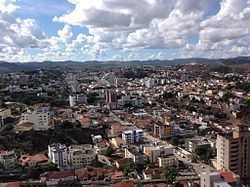Country Brazil State Minas Gerais Microregion Teófilo Otoni Elevation 334 m Population 105,621 (2010) | Region Southeast Mesoregion Mucuri Valley Founded September 7, 1853 Area 3,243 km² Local time Thursday 4:56 AM | |
 | ||
Weather 19°C, Wind N at 5 km/h, 93% Humidity | ||
Téofilo Otoni is a city in northeast Minas Gerais state, Brazil. The population of the municipality was 140,067 in 2013 and the area is 3,242.818 km².
Contents
- Map of TeC3B3filo Otoni State of Minas Gerais Brazil
- Origin of the name
- Location
- Statistical Microregion
- The economy
- Agricultural Data
- Mining
- Health and education
- Famous people
- References
Map of Te%C3%B3filo Otoni - State of Minas Gerais, Brazil
Origin of the name
The city is named after Teófilo Benedito Ottoni (Vila do Príncipe, 27 January 1807 - Rio de Janeiro, 17 October 1869), who was a provincial deputy representing Minas Gerais; a national deputy and a senator in the Empire of Brazil from 1864 to 1869; and founder of the city of the same name.
Location
It lies at an elevation of 319 meters on the Todos os Santos River, a tributary of the Mucuri. It is part of the Valley of the Mucuri, a region which includes 27 municipalities. Situated on the Rio-Bahia Interstate Highway BR 116, it is 130 km. north of the regional center, Governador Valadares, on the Doce River, and 478 km north of the state capital, Belo Horizonte. It was founded in 1853 by German colonists and given city status in 1878.
Municipal boundaries are with:
Distances to important cities:
Statistical Microregion
Teófilo Otoni is a statistical microregion including the following municipalities: Ataléia, Catuji, Franciscópolis, Frei Gaspar, Itaipé, Ladainha, Malacacheta, Novo Oriente de Minas, Ouro Verde de Minas, Pavão, Poté, Setubinha, and Teófilo Otoni. The population of this region was 253,679 in 2000 and the area was 11,296.80 km² (roughly the size of The Gambia and a little larger than Jamaica. The population density was 22.46 inhab/km².
The economy
Teófilo Otoni is a trade centre for an agricultural hinterland in which livestock raising is of some importance. The city has small-scale manufacturing and food-processing plants. Poor soils for agriculture and lack of industry have made Teófilo Otoni a major source of immigration to other regions of Brazil. In 2005 the GDP was R$723 million, of which 515 million was from services, 101 was from industry, and 37 million was from agriculture. Industry employed about 2,000 workers, services employed 8,800 workers, and public administration employed 2,300 workers.
Téofilo Otoni's strongest economic sector is a diverse and bustling service industry. The city has several commercial areas and a shopping mall, City Mall. Prominent businesses in Teófilo Otoni include Pharmacy Indiana, Stationery Graffite, the store Magda Magazin, and Ramos Transport. The trade in precious stones is also quite important as the city is considered an International Capital of Precious Stones, which comprises a good portion of its economy.
The city was granted the FIPP (International Fair of Precious Stones) recognized worldwide.
Agricultural Data
Mining
Extensive mining and gem trading for aquamarines, topaz, brazilianite, and various forms of quartz take place there. A Gem and Mineral Show (Feira Internacional de Pedras Preciosas (FIPP), is held here every year, attracting international buyers. The fair provides the opportunity to buy both rough and cut stones directly from local producers, miners and cutters.
Health and education
The population was served by 61 health clinics and 4 hospitals (417 beds in 2005). There were several institutes of higher education: Faculdade de Tecnologia Egídio José da Silva (private), Instituto de Ensino Superior Integrado (private), Instituto de Educação Superior São Francisco de Assis de Teófilo Otoni (private philanthropic), and Faculdades Unificadas Doctum de Teófilo Ottoni (private)
Municipal Human Development Index
